Abteilung Spin und Topologie in Quantenmaterialien
Methods and instrumentation for MML: ARPES, PEEM and vector magnet based methods
Materials for Green Spintronics: Research on matter with brilliant light sources
The research program within the department covers practically all basic phenomena that lay the ground for future spintronics. These phenomena are investigate at various length, time, energy and temperature scales at the synchrotron radiation source BESSY by means of Photoemission electron microscopy (PEEM), angled-resolved photoemission spectroscopy (ARPES) and scanning transmission microscopy (STM).
Photoemission electron microscopy
Magnetic nanostructures are at the heart of modern data storage technology. Typical dimensions of magnetic bits are in the sub-100nm region. In addition novel magnetoelectronics devices such as magnetic random access memory junctions are operated on the sub-100nm m scale. An understanding magnetic properties of such low-dimensional structures is only accessible to spectro-microscopy tools capable of appropriate lateral resolution. This goal is achieved by combining a novel spin-resolved photoemission microscope (SPEEM) with a dedicated microfocus PGM beamline with full x-ray polarization control (UE49-PGM).
The synergy between the microscopy capabilities of the PEEM and the polarization control of synchrotron radiation makes of X-PEEM the ideal tool for space resolved and element selective investigation of nanostructures by means of chemical maps (XAS) and magnetic imaging (XMCD and XLD).
The recent upgrade of the microscope allows for magnetic and spectroscopic imaging in a wide temperature range (60 K to 600 K) under applied magnetic and/or electric fields. For more information visit the following link XPEEM
Angle resolved photoemission spectroscopy
13 ARPES
This experiment is built in a collaborative effort by the IFW Dresden, TU Dresden and the HZB, to enable experiments that require the highest energy resolution at ultimately low sample temperatures. To achieve this goal, all contributions to experimental broadening ---the resolution of both the excitation source and the electron energy analyzer as well as the sample temperature--- have been reduced to ≤1 meV or their equivalent, yielding the name of the station: 1 meV x 1 meV x 1 K = 13.
12 ARPES
The 1 squared ARPES system is aimed at a much wider spectrum of angle-resolved photoemission experiments than its 1 cubed sibling. The system is equipped with a manipulator with 6 degrees-of-freedom (the IFW Dresden designed Cryoax 6) that allows for a much broader exploration of reciprocal space. In addition, the system has versatile sample handling and preparation facilities.
PHOENEX
Phoenex is a movable system for spin-resolved ARPES. It features a Specs Phoibos 150 electron energy analyzer equipped with a Mott detector for 2 channel (in-plane) spin detection. It has an additional array of 6 channeltrons for spin-integrated detection. The system is equipped with a 5-axis manipulator (translation + polar and azimuthal rotation) and has built-in magnetization coils. PHOENEX is most commonly used at the UE112-PGM1 and U125/2-SGM beamlines.

